After rejecting ( because not sourdough) the idea of this bake for a few months I decided to give this formula a try. Since it uses vinegar, lactic acid and yeast, I am way out of my wheel house. But I am a sour freak and I’ll try most anything. Doughooker has obviously spent a lot of time researching and experimenting. His knowledge of Sanfrancisco SD seems impressive and I’ve learned a lot of history from reading his articles.
Doughooker, aka Chris has an excellent Writeup HERE.
I tried to follow the instructions as closely as possible. The speed at which this bake progresses is super fast. So, slow polk sourdough bakers - beware...
I took extra care in weighing out the ingredients. The dough was kneaded by hand. I wanted to feel the dough as it developed. At 63% hydration the dough was a little sticky and the gluten never did smooth out to my liking. I took care not to over knead. I am thinking that the acids had something to do with that. I look forward to the opinions of others on this.
The image below shows the dough after kneading. As stated, I was unable to develop a smooth skin.
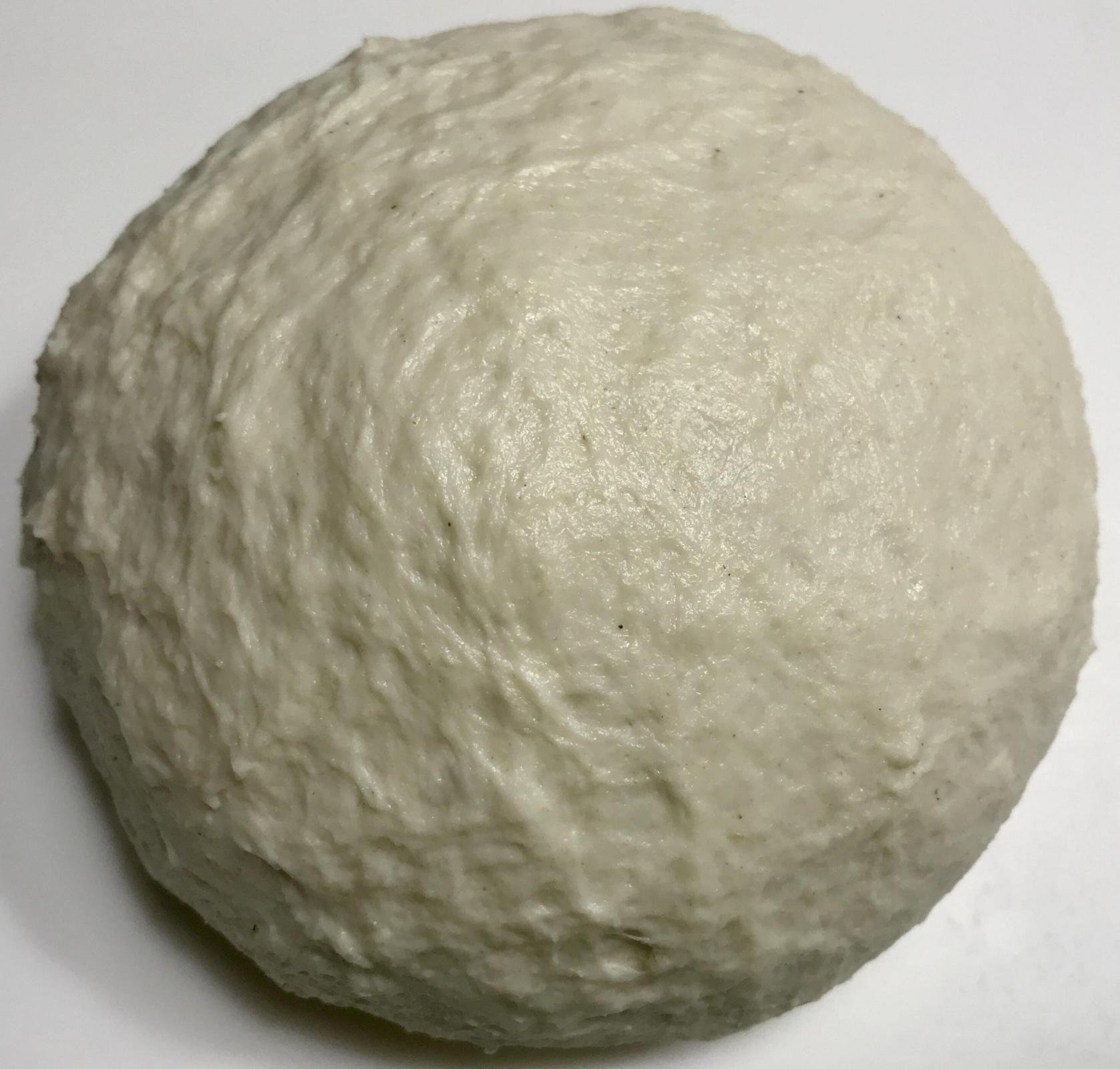
The image below shows the damaged gluten. This was taken just after the proofing began.
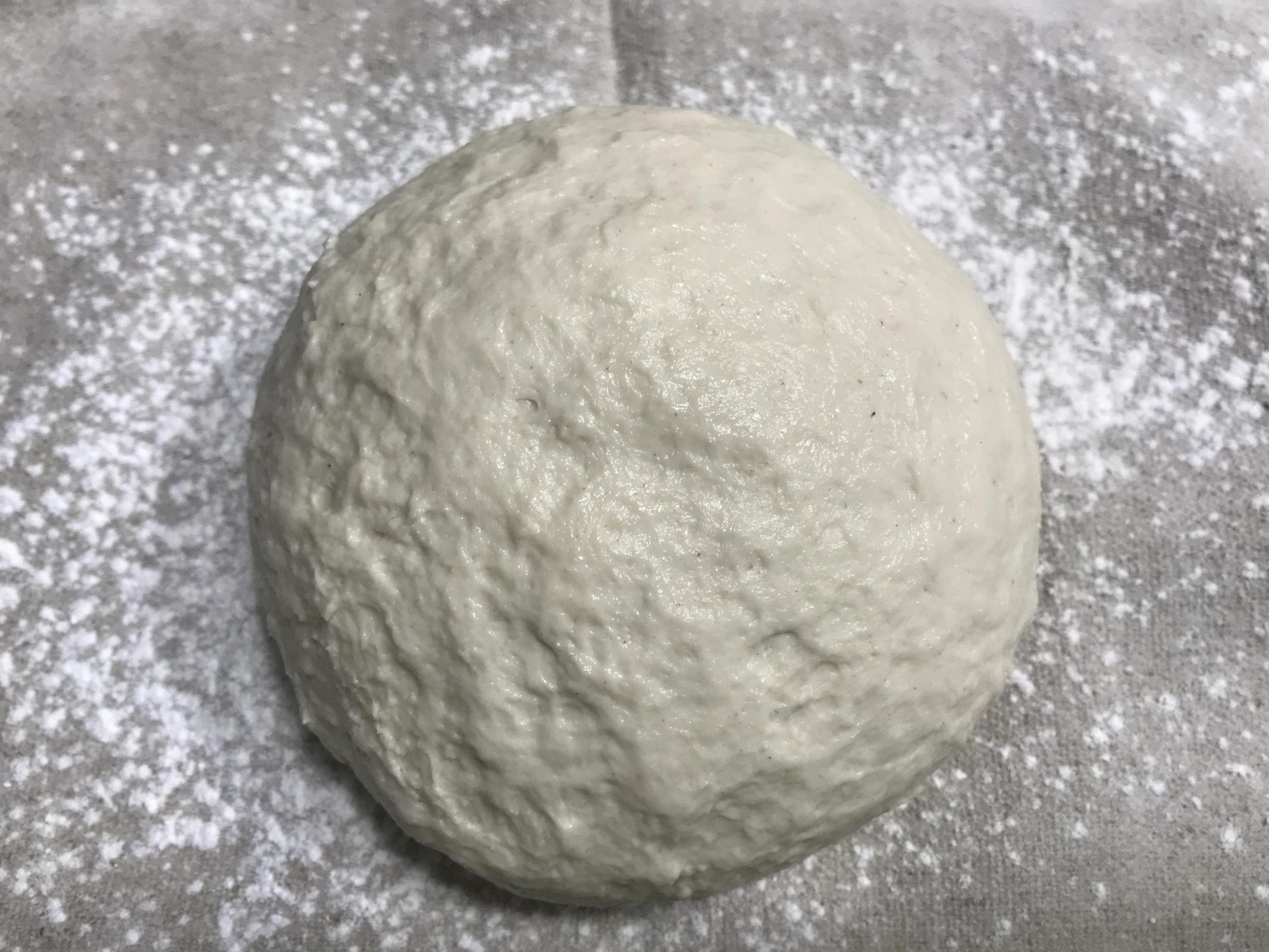
Before entering the oven, the dough had proofed 2 hours. It was puffy and appeared over proofed. Because of this, I elected to not score the dough. Instead the dough was placed seam up in the Graniteware roaster.
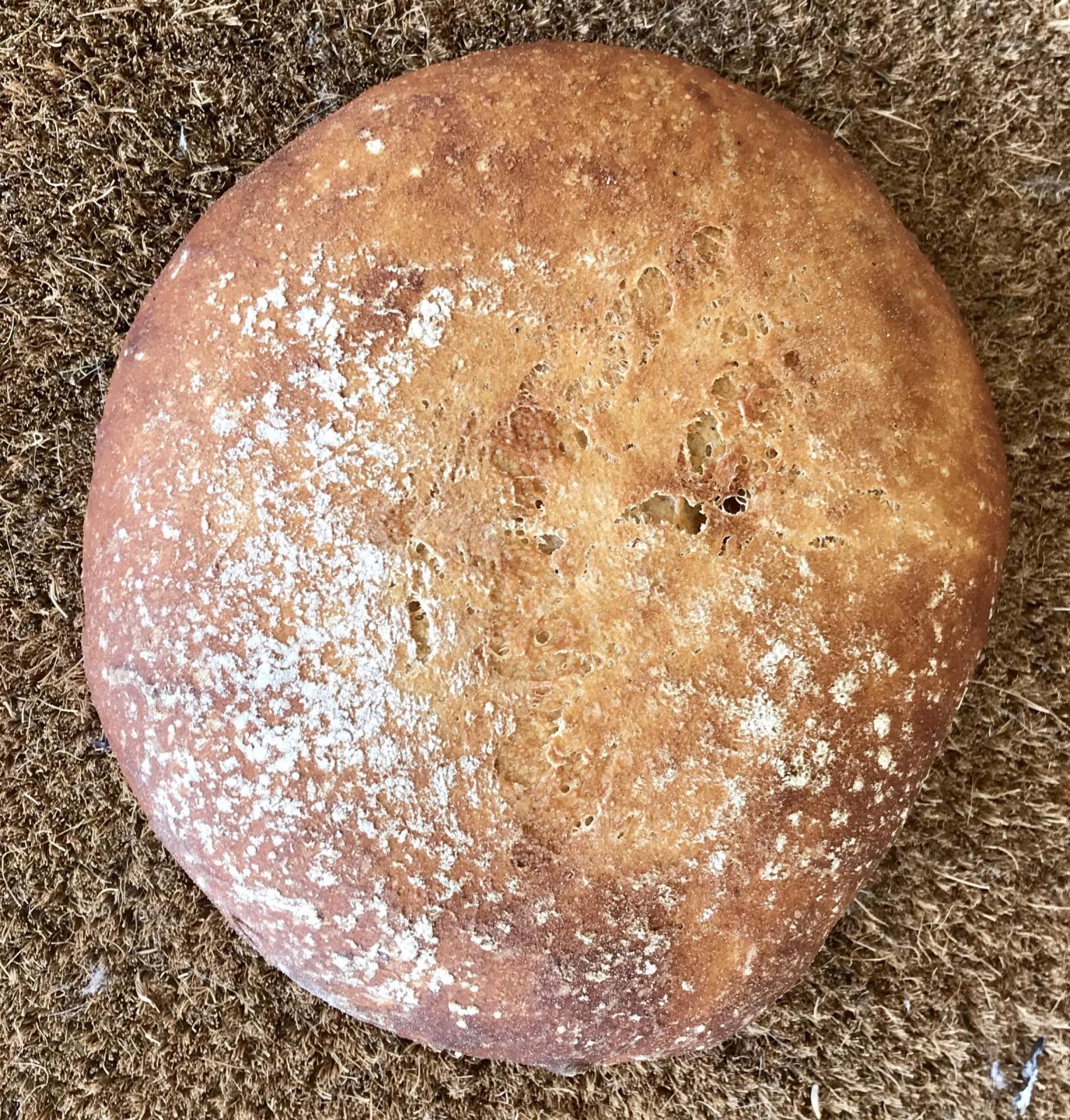
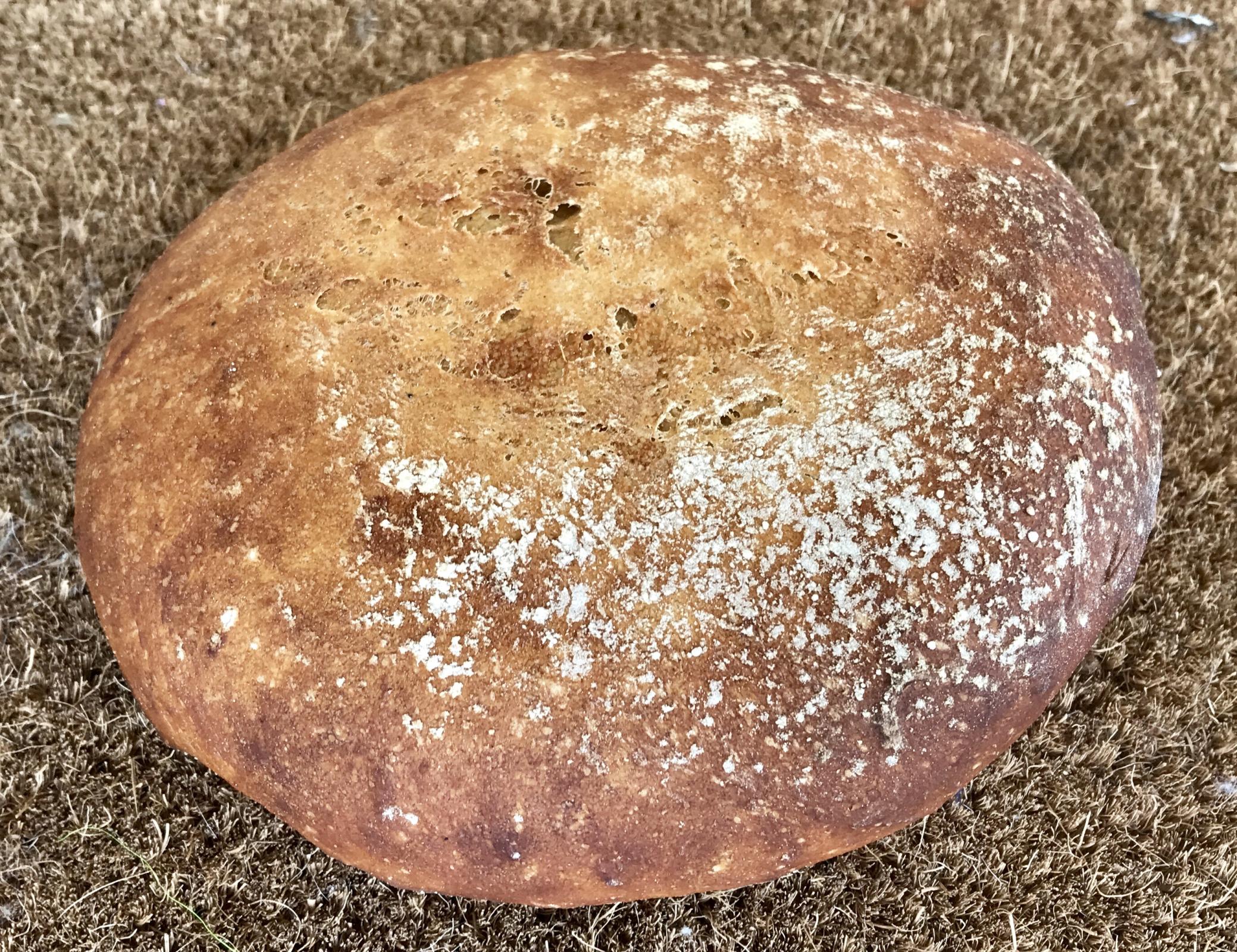
The bread has a very nice smell. I don’t think I’ve ever experienced this smell before. <I am excited>
OH! Stick to Chris’ baking instructions. I couldn’t find the instructions online when the dough was ready to be loaded. I started out at 460F. The diastatic malt will darken a loaf, so be careful with your heat.
Update - bread has been sliced.
I definitely over proofed the dough. To be honest (and I hate to say it) the flavor did not meet my expectations. I like a strong, predominant lactic sour. Unfortunately, I didn’t detect much sour at all. I was concerned about staling, since the bread fermented for such a short time. That seems to be the case.
I hope others bake this bread and have very different results. I followed the formula to the 10th of a gram, and as far as I know the proper and exact ingredients were used. I hope I missed something. I really wanted this bread to work. <Sorry Chris :-(>
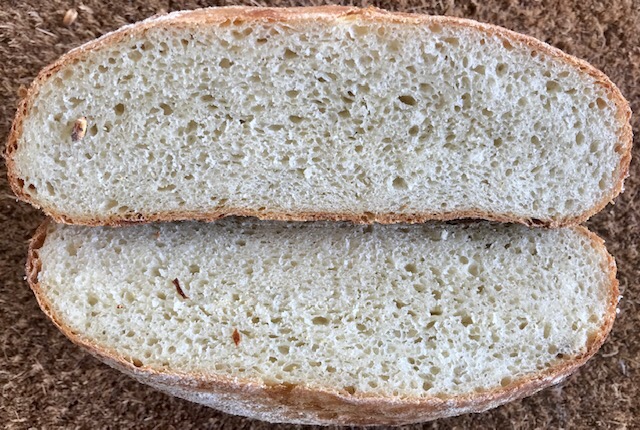
Danny
The behavior is similar to what you see when you acidify a dough to the point where the gluten degrades either under the direct influence of the added acid or indirectly through the activation of the native proteolytic enzymes in the flour which occurs at low pH (typically below 4).
It turns out that the lactic acid (Druids Grove) is 60% lactic acid and 40% Ca lactate, and thus is heavily buffered. The lactic acid in (real) sourdough is not buffered by Ca lactate.
Doughooker, have you experienced the degraded dough problem that I experienced?
"Doughooker, have you experienced the degraded dough problem that I experienced?"
As this stage I'm more concerned with flavor than texture. That you didn't detect much sourness concerns me.
Doc, in order to know for sure that the lactic acid and vinegar are causing the problem, should I mix the dough with both acids and hold back a little water. Then develop the gluten. After the gluten is developed, the acids and holdout water are then added. If the acids are the problem I should see the dough break down shortly after.
Does this sound right?
"Doc, in order to know for sure that the lactic acid and vinegar are causing the problem, should I mix the dough with both acids and hold back a little water. Then develop the gluten. After the gluten is developed, the acids and holdout water are then added. If the acids are the problem I should see the dough break down shortly after."
Danny - see my blog.
Let's try changing one thing at a time so we're not going off in too many directions at once.
Just split a batch and make half with the acids and half without. It is pretty clearly the acid(s) that are making things difficult. This may be why commercial sourdough mixes do not use lactic acid.
I don't know what luck you would have with a more pure form of lactic acid which might come as a liquid concentrate. You might try citric, malic, or fumaric acid as an alternative since you can get them unbuffered and they have molecular weights higher than lactic acid.
"I don't know what luck you would have with a more pure form of lactic acid which might come as a liquid concentrate. You might try citric, malic, or fumaric acid as an alternative"
Citric, malic or fumaric acids won't give you the same flavor, I would think.
Maybe it's time to take a different tack.
We have the vinegar part down.
The USDA recipe calls for sour whey:
"researchers on the other side of the continent, at the USDA's Eastern Regional Research Laboratory in Wyndmoor, Pennsylvania, worked with industry to develop a simple new procedure for making the bread. It used sour whey and vinegar instead of bacteria as sources of acetic and lactic acid. When the acids are added to a French bread formula in the quantities and proportions found in the traditional product, the result is a bread with the resilient body, robust flavor, coarse structure, and crisp chewy crust of the native San Francisco product."
Are you still with us, Danny?
We're going to try changing the way the dough is initially mixed, per Doc.dough's suggestion. It will basically get a mini-autolyze before the salt, lactic acid and vinegar are added.
See my blog for details.
Thanks to Danny and Doc-dough for their interest and input.
I'm going to try this tomorrow (Saturday) per your recipe and include Doc.Dough's 15 minute autolyse.
I'll let you know how it turns out.
Protein denaturation and coagulation.
Just as I would expect. Acid directly impacts gluten and weakens it. Seen this before.
Increased acid will also close up the crumb.
"Protein denaturation and coagulation.
Just as I would expect. Acid directly impacts gluten and weakens it. Seen this before.
Increased acid will also close up the crumb."
Might this happen with a conventional sourdough starter which has the same acids in similar quantity?
Yes, although in practice it occurs later in the process after gluten development and the formation of a leavened structure because the acid builds up gradually.
I would definitely consider looking at mixing the acid in after gluten is developed. E.g. as part of a double hydration technique. It could help... Maybe!
Interesting question. Note that in conventional sourdough, gluten development occurs early in the process and the acids accumulate later and thus may not be affected in the same way as if they are exposed while the gliadin and glutenin are still dancing around making and breaking contact. Compare the results of using a large innoculation (perhaps[s 40% of the flour is in the pre-ferment) of a long-fermented levain that has a high hydration which dilutes the acids produced during fermentation, with a batch of bread that uses 5% of the flour in the pre-ferment. In the first case gluten formation occurs in the presence of fairly high TTA while in the second case the TTA increase occurs mostly after the gluten has been formed. The synthetic souring that you are achieving is an extreme version of case 1.
I like the notion of trying to incorporate the acids late in the process as part of a bassinage, and I suspect that some additional hydration would not be a big negative – certainly not for a test run at least.
Thank you, fellas.
"I like the notion of trying to incorporate the acids late in the process as part of a bassinage"
I definitely plan to do that. Please see my blog.
http://www.thefreshloaf.com/node/49375/san-franciscostyle-sour-bread#comment-429427
Danny -
How long did you proof your loaf and how long after baking did you let it cool?
If you don't detect much sourness then something is wrong. On the other side of the coin, too much sourness will taste just plain weird and you don't want that. My loaves are as sour as they can get without tasting weird.
What concerns me most is why Danny is tasting so very little sourness.
If he followed the directions to the letter, as he says he did, he should taste at least a little bit of sourness, a little bit of vinegar taste.
Here is a source for 88% lactic acid (based on other products I think it is probably L(+) lactic acid and water but I don't know). It should not have any calcium lactate in it. You can also find it in smaller quantities.
https://www.homebrewing.org/Lactic-Acid-88--32-oz_p_7064.html
The Druids Grove product is 60% lactic acid (probably DL) and 40% calcium lactate so you have to apply a correction factor when calculating the TTA of any bread you make with it.
You're right, it's printed on the label, ingredients are only lactic acid, water.
https://blogs.scientificamerican.com/guest-blog/enzymes-the-little-molecules-that-bake-bread/
How to protect gluten in a weak dough
https://thebakingnetwork.com/protecting-gluten-in-a-weak-dough/
One of the biggest myths in bread making is that protease action will break down your dough especially if its a white bread. There is very little protease left in white flour since most of it is found in the bran and germ that is removed in the milling process. You would have to do something really weird with your SD bread making process to have protease break down your gluten in white bread..
When it comes to enzynes the 4 things to remember are temperature, salt, acid.and hydration.
Happy baking
It is pretty clear that Teresa Greenway has never actually tested the truth of her claims. First, and most obvious, is the claim that autolyse has something to do with proteolytic enzyme activity. It does not. The only enzymes that are active during autolyse are the amylase enzymes that are busy breaking down starch and making maltose. And if you chase down a copy of Calvel and read about autolyse from cover to cover you will find no claims that there is any proteolytic activity involved in getting the benefits of autolyse. Once the flour has come to equilibrium with the water, and the amylase has provisioned the dough with enough maltose to prime the yeast and LAB, then you have got everything you are going to get from autolyse and you can proceed to the next stage. After that, in most cases, the amylase will stay ahead of the biological demand for maltose. A warm autolyse allows it to happen faster and be done sooner, both on the water absorption side and on the amylase activity side. I challenge anybody to demonstrate with a repeatable experiment that there is any significant proteolytic enzyme activity in white flour bread dough at a pH above 5.0
It is well known the use of an autolyse is a way to reduce mixing times and therefore reduce over-oxidation which can destroy carotenoid pigments. That is its primary purpose and the reason for its adoption.
Autolyse has everything to do with proteolytic enzymes.
Flour contains an abundance of various enzymes not just amylases. (proteases, lipoxygenases, peroxidases and more)
There are many proteases that act upon proteins and not just those acidic ones you are referring to. I.e. aspartic which are activated when the dough becomes very acidic.
Proteases can be acidic, neutral or alkaline.
Cysteine/thiol proteases are neutral and help to soften gluten.
Flours that have a low stability (farinograph) or those that are weak tend to be less suited to an autolyse. Many re-milled durum flours have this quality and if you leave them to autolyse too long their performance is seriously compromised.
Rani, K.U., Rao, U.P., Leelavathi, K. and Rao, P.H., 2001. Distribution of enzymes in wheat flour mill streams. Journal of Cereal Science, 34(3), pp.233-242.
Van Oort, M., 2010. Enzymes in bread making. Enzymes in food technology, p.103.
What can you do with readily available materials that will conclusively demonstrate that there is proteolytic enzyme activity in a white flour bread dough at a pH above 5.0?
I am not saying that you can't find an enzyme that will do it, I am saying that it is not something that happens in widely available bread flour(s).
And I couldn't find any thiol proteases that have an optimum pH above 5.0 and also occur in bread flour. If you can point to a paper reporting such an enzyme I would like to read it.
"Papain cysteine proteases have optimum activity at neutral pH" [1]
"Triticain-α is a papain-like cysteine protease from wheat (Triticum aestivum L.) that possesses activity towards toxic gluten-derived peptides" [2]
"Cysteine proteinases are mainly located in the starchy endosperm." [3]
[1]. Mamo, J. and Assefa, F., 2018. The role of microbial aspartic protease enzyme in food and beverage industries. Journal of Food Quality, 2018.
[2]. Gorokhovets, N.V., Makarov, V.A., Petushkova, A.I., Prokopets, O.S., Rubtsov, M.A., Savvateeva, L.V., Zernii, E.Y. and Zamyatnin Jr, A.A., 2017. Rational design of recombinant papain-like cysteine protease: optimal domain structure and expression conditions for wheat-derived enzyme triticain-α. International journal of molecular sciences, 18(7), p.1395.
[3]. Brijs, K., Trogh, I., Jones, B.L. and Delcour, J.A., 2002. Proteolytic enzymes in germinating rye grains. Cereal chemistry, 79(3), pp.423-428.
I am in no way an expert on the subject.
But I know proteolytic and oxidative reactions occur as part of gluten development.
An autolyse could be considered a reductive phase where gluten can soften and relax while peptide bonds are broken between gluten proteins by cereal proteases.
Another aspect with an autolyse is that with limited mixing and therefore oxidation one liberates naturally occurring reducing agent glutathione.
Running experiments is your prerogative and your "challenge" is not something I am interested in. I know from experience the benefits of an autolyse and how flour, including white flour degrades all on its own. But if pressed, I would look at mixing time to reach full development based upon varying lengths of autolyse.
Either way flour is abundant in enzymes that will degrade it. That was always the intention of the wheat plant.
Good resources:
Bakery technology - Enzymes see sulfhydryl proteases and their optimum pH range.
https://muehlenchemie.de/downloads-future-of-flour/FoF_Kap_18-5.pdf
All the best,
Michael
You have loaded my reading list, so I will go see what I can learn.
And hopefully that will produce the elusive repeatable demonstration of proteolytic behavior during autolyse.
I have started draining the sour whey from a quart of plain yogurt, and have sent email to the USDA in Wyndmoor, PA requesting the complete formula for their sourdough bread using sour whey and acetic acid (vinegar).
Here are some articles on sourdough using sour whey, but I don't know how they compare to the USDA recipe.
https://food-hacks.wonderhowto.com/how-to/yogurt-trick-will-help-you-get-professional-tasting-sourdough-bread-home-0169502/
http://ladyandpups.com/2014/10/16/fraudulent-easy-sourdough/
For convenience I have copied the recipe here:
CHEATER’S EASY SOURDOUGHIngredients
Instructions
Chris, I have used Whey before. I don’t think it will get you the sour you want. I actually have made my own yogurt and used the whey in bread.
BUT, I have no experience with yogurt at a room temp ferment for 18-20 hours. I can tell you the actual temp of the RT makes a huge difference in the ability of the dough to maintain it’s strength.
An excellent baker on the site is Danni3113. She uses whey all the time and I don’t think she likes sour at all. Keep in mind, she doesn’t use commervial yeast, though.
It looks like you have a number of experiments going. Once you narrow things down, let me know. Until then, I’ll take a seat in the back and watch you. I enjoy structured experimentation.
Dan
Danny -
Right now I'm concentrating on the USDA whey/vinegar recipe which has been tested more thoroughly. The lactic-acid powder is experimental and is taking a rest for the moment. Your lack of success with the lactic acid powder was discouraging, but the recipe makes satisfactory bread for me. It is a mystery why it doesn't work equally well for you.
I will keep you posted and will need your help in testing all this.
Once you settle on a process and formula, let me know and I’ll bake along with you to confirm your findings.
Danny
I am in the process of running a percentage of BF comparative test tonight. The test is proceeding well. Final results should be posted tomorrow or Monday.
"Once you settle on a process and formula, let me know and I’ll bake along with you to confirm your findings."
Thank you for offering, but we haven't determined why you didn't get the same results I did in the first go-round. Do you want to try to unravel that mystery?
If our results don't match then we have a problem somewhere. I didn't experience the same lack of sourness and early staling that you did.
I asked Doc Dough about the whey equivalent of Druid's Grove acid and he didn't have one.
Hopefully the USDA in Pennsylvania will have the original formula.
Chris, since Doc mentioned a more concentrated acid, should we compensate by using more Druids Grove LA?
I’m going to PM Doc and ask his opinion. I’ll let you know what he thinks.
OR would you prefer to keep the percentage as is?
Danny -
Would it be asking too much to try another bake using Doc.dough's preferment idea?
mix the IDY with the flour and malt (no salt) then add 130°F water and stir to incorporate and make sure all of the flour gets wet. Let it sit for 15min then mix and incorporate everything else during the mix. That way the amylase makes maltose from the starch (which also goes faster at higher temperatures) and the yeast gets off to a good start before you add the salt and acids that can mess with the metabolism.
Mabe later. I’m in the process of completely updating our house. The lastest experiment ate up a lot of time. I committed to that test some weeks back.
My initial interest in your sour bread was the possibility of supplementing my Levained SFSD with possibly vinegar and/or Lactic Acid. I can’t think of anything I won’t try in order to intensify the sour flavor of an all white SFSD.
I am very pleased with the SFSD I bake, but I’ve never had a bread that was too sour, YET.
Chris, I just saw your updated post. It is an easy bake, so I’ll try to get to it this week. My wife has got to love me...
Don't go overboard trying to add extra sourness or you will have a funny-tasting loaf.
Therein lies the secret. How far can we push without shoving it over the cliff.
Has your testing revealed the limit of acid? Have you pushed it over the cliff :D
Oh yes, I have pushed it over the cliff. I would say more than 1.3 g of lactic acid powder will make it taste odd and artificially over-soured.
But you want to add lactic acid to a loaf made with starter. That's different. Maybe just a few tenths of a gram?
Oh OK. So I assume we will stick to your original formula for the test. WOW, that acid must be powerful.
Speaking of powerful; diastatic malt must be respected also. “A little dab will do you”. Anyone remember Dippity-Do?
"I assume we will stick to your original,formula for the test."
In terms of ingredients, yes, but we should adopt Doc.dough's mixing method. See my blog. It is toward the bottom.
Rght On.
I remember "A little dab will do ya"... but I think I remember that from my father saying it.
I remember "A little dab will do ya"
It's from Brylcreem.
Yea, you’re right. My bad, Brylcreem it is. A trip down memory lane. Our world was so different back then.